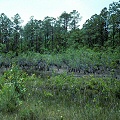Q: How did Carolina Bays form?

Carolina Bay
The bottomlands of North and South Carolina are
home to an interesting kind of landform referred to as Carolina Bays. While much
of the coastal southeast USA is dotted with randomly shaped, irregular wetlands, Carolina Bays have peculiar commonalities and
symmetries. For example, they are all elliptical,
with semimajor axes that all point in the same approximate direction (northwest-southeast).
They also share other features like raised sandy rims. Carolina Bays range from
about 70 meters to longer than 10 km long.
As you'd expect for any depression in the bottomlands, these Bays are often filled with water---they may be lakes, or
sphagnous wetlands perfect for carnivorous plants. Such Bays are not unique to the Carolinas. They also occur in Delaware,
where they are called Delmarva Bays.
But how did such structures form? First, there are the crank theories that propose they were
holes created by the thrashings of stranded
whales. Uh huh! (For this reason, some are referred to as whale wallows!)
A more reasonable set of theories propose that these
structures are formed by erosional wind or water forces, the same kind of forces that probably create the Mima mounds of California,
the patterned grounds in tundra, or periodic spacings of dunes seen in the desert. Some think they may have originated from
a modification of kettlehole bogs created by receding glaciers (but this doesn't really explain the ellipticities).
Any of those theories have a good deal of additional work before they can really claim to explain the origin of Carolina Bays.
Why are they unique to the eastern seaboard of the USA? Since craters and other surface features on the Earth are eroded very rapidly,
these Bays must be extremely recent phenomena and are probably being sustained in their current form. What is doing this?
An interesting mystery indeed!
An old theory about Bays is that they were formed by astronomical impacts---when you
look at the elliptical nature of the Bays (craters?),
this appears to be a good theory. Surely the ellipticity would indicate a sloping trajectory of the incoming object? However, this
theory can be rapidly discounted for several reasons--and if you don't mind, I'm going to take this opportunity that in my working gig, I'm a college
astronomy professor, with a Ph.D. in astronomy...so I do know quite a bit about what I'm talking about here.
- Astronomical impacts involve supersonic collisions. Supersonic releases of energy spread out from the point of impact
symmetrically, and excavate circular craters. Look at photographs of the moon---it is covered
with circular craters, and not elliptical ones.
- Arguing that the impact was nonsupersonic would be completely unprecedented. Even the sluggish space shuttle traveled at supersonic
speeds. To suggest an astronomical object would strike the Earth at subsonic speeds would be so
improbable as to be laughable.
- Searches for meteoric material in and around Bays have all been unsuccessful. Yes, I know that
the Tungusta blast (probably a cometary chunk) of 1908 left no meteoric material, but it also did not create any kind of
crater.
- Hybrid hypotheses (an impact from loose aggregates of quasi-cometary/asteroids) represent really weak science, as such things have
never been observed. One is simply positing an unknown entity, to explain an unexplained observation. Yes, of course I know about Shoemaker-Levy, etc.,
but you still have the
unresolved problem of supersonic collisions creating circular craters, not elliptical ones.
- Recall finally that there are Delmarva Bays in Delaware, as well as Carolina Bays in the Carolinas. If you want to invoke some kind of extremely unlikely, unprecedented cratering event to explain Bays, you have to invoke it TWICE. So now your hypothesis has become even more unlikely.
Those interested in cratering issues are encouraged to read books on astronomical "geology",
(see citation list below). There you'll even read about multiple-cratering events, but none of them end up looking like
Bays. So exactly what creates and maintains Carolina and Delmarva Bays? It is hard to say! But they certainly are very cool!
Page citations: Hartmann, W.K. 2003; Hartmann, W.K. pers. comm. 2006;
personal observations.